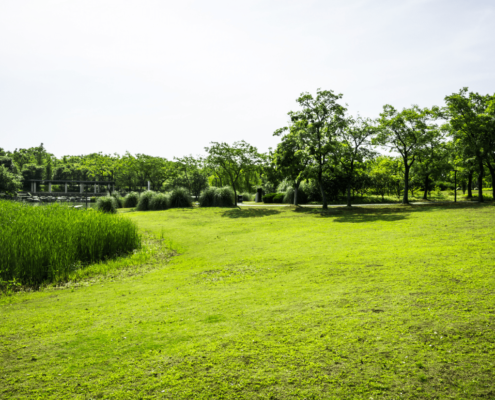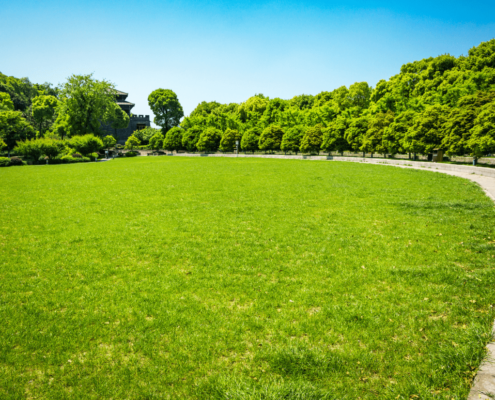Exposed! #1 Grass Seed for Shade and Sun
Maintaining a lush, green lawn can be a challenge when your yard is a mix of both shaded and sun-drenched areas.
But have no fear, we have a solution:
The #1 Shade and Sun Grass Seed
By using specially formulated seed blends, you can ensure that your entire lawn will stay healthy and vibrant, no matter the amount of sunlight it receives throughout the day.
An EXCELLENT option to consider is the Shady Turf Grass Mix.
The Shady Turf Grass Mix is a blend of grass species that are suitable for your specific region. This turf grass mix is specially crafted to thrive in the local climate and growing conditions, whether in sun or shade. With its resilient nature, it promises to give you a beautiful lawn that lasts all year round.
Why should you consider using grass seed for shade and sun in the first place?
Using a grass seed that is intended for both sun and shade comes with three key benefits:
- Adaptability: Sun and shade grass seed mixture is specifically formulated to be versatile and adaptable to a range of light conditions. Whether your lawn receives full sun, partial shade, or deep shade, this blend ensures that every part of your lawn thrives.
- Uniform Appearance: Using a grass seed for shade and sun guarantees a uniform appearance across your entire lawn. No more stark contrasts between patchy, bare spots in the shade and overgrown areas in the sun. With grass seed for shade and sun, your lawn will have a consistent, well-groomed look.
- Reduced Maintenance: By using a sun and shade grass mix, your lawn maintenance becomes easier and more efficient. You won’t need to purchase and apply different products depending on the level of sunlight in different areas. This saves you time, effort, and money in the long run.
Searching for the perfect sun and shade grass mix?
As an alternative to The Shady Turf Grass Mix, here are three other excellent options to consider:
- Kentucky Bluegrass Blend: Kentucky Bluegrass is a popular choice for many homeowners due to its ability to thrive in a range of light conditions, from full sun to partial shade. This blend combines the benefits of Kentucky Bluegrass with other cool-season grasses to create a lawn that is both beautiful and resilient.
- Fine Fescue Blend: Fine Fescue is known for its shade tolerance and ability to grow well in low-light areas. This blend often combines fine fescue varieties such as creeping red fescue and chewings fescue with other grass types to provide a balance of shade tolerance and durability.
- Perennial Ryegrass Mix: Perennial Ryegrass is a fast-growing grass that performs well in both sun and partial shade. This mix combines the benefits of perennial ryegrass with other grass species, creating a lawn that is quick to establish and capable of withstanding heavy foot traffic.
What is Sun and Shade Grass Seed?
Sun and shade grass seed is a type of grass seed that is specially formulated to grow in areas that receive varying amounts of sunlight.
All sun grass seeds are typically composed of several different varieties of grass, each of which has its own set of requirements regarding sunlight, soil, and moisture.
By blending these different types of grass together, grass seed for sun provides a comprehensive solution for homeowners who want a healthy and vibrant lawn, regardless of the light conditions in different areas of their yard.
Direct Sun Grass vs. Sun and Shade Grass
When it comes to choosing the right grass seed for your lawn, there are a couple of factors to consider, including the amount of sunlight your yard receives.
Two popular options for different light conditions are direct sun grass and sun and shade grass.
Key Differences Between Direct Sun Grass and Sun and Shade Grass
The main differences between direct sun grass and sun and shade grass lie in their adaptability to specific light conditions:
- Light Requirements: Direct sun grass is specially formulated to thrive in areas with intense, direct sunlight for the majority of the day. It is heat and drought tolerant, with varieties that can withstand high temperatures.
On the other hand, sun and shade grass is designed to grow successfully in areas with varying degrees of sunlight, from full sun to partial shade. It blends different grass varieties to ensure uniform growth and appearance throughout the entire lawn. - Shade Tolerance: Direct sun grass is less tolerant of shade than sun and shade grass. While direct sun grass may struggle to grow in shaded areas, sun and shade grass seed is specifically formulated to adapt to lower light conditions. It contains grass varieties that can still thrive in areas with limited direct sunlight, ensuring a healthy and lush lawn in both sunny and shaded areas.
Areas Convenient for Each Grass Seed Type
The choice between direct sun grass and sun and shade grass depends on the light conditions in your area. Here are the regions where each type is most convenient:
- Southwestern states with hot and arid climates, such as Texas, Arizona, and Nevada.
- Southern states with long, hot summers, like Florida and Georgia.
- Areas with high exposure to direct sunlight and minimal cloud cover for most of the year.
Sun and Shade Grass:
- Northeastern states with varying light conditions, including Massachusetts, New York, and Pennsylvania.
- Pacific Northwest states with frequent rainfall and cloudy days, such as Oregon and Washington.
- Any region with areas of both sun and shade within the same yard.
| Key Factors | Direct Sun Grass | Sun and Shade Grass |
|---|---|---|
| Light Requirements | Thrives in intense, direct sunlight | Grows well in varying light conditions |
| Shade Tolerance | Low tolerance for shade | Adapted to lower light conditions |
| Recommended Areas | Southwestern and Southern states | Northeastern and Pacific Northwest states |
Our conclusion is that finding the perfect grass seed for shade and sun is crucial for maintaining a healthy and vibrant lawn, regardless of the light conditions in different areas of your yard.
Shady Turf Grass Mix, Kentucky Bluegrass Blend, Fine Fescue Blend, and Perennial Ryegrass Mix are all excellent options to consider when searching for the right seed blend.
By choosing the appropriate seed blend for your lawn, you can create a beautiful and resilient landscape that will be the envy of the neighborhood.
Sun and Shade Grass Seed FAQs
Q: What is the best grass seed for shade and sun?
A: For lawns that have both sunny and shaded areas, Shady Turf Grass Mix is the best option in our opinion and experience. The mix contains Buffalograss Improved and Blue Grama Native that can grow well in low light areas, along with sun-loving Kentucky bluegrass suited for sunny areas. This combination of grass seeds is perfect for homeowners who are seeking to achieve a lush and uniform lawn in both sunny and shaded areas.
Q: What type of seed is in sun and shade mix?
A: The seed mix consists of Bluegrass, Ryegrass, and Fescue. The Ryegrass and Fescue typically germinate within 2 weeks, while the Bluegrass may take up to 28 days to sprout.
Q: How often should you water sun and shade grass seed?
A: To ensure proper growth, the watering should provide the same amount of moisture throughout the lawn, with less water in shady areas. I will recommend watering the grass twice daily until it is up, then reduce to once per day after one week. Adjust the watering pattern as needed according to the season and temperature demands.
Q: How long does it take for sun and shade seeds to germinate?
A: For areas of your lawn that receive 4 to 6 hours of sun each day, we recommend planting this seed mix in early spring or early fall. You can expect to see noticeable results in just 8 to 21 days. Our sun and shade grass seed mix is perfect for lawns that need a balance of sun and shade. It is resistant to diseases and can withstand drought conditions. The mix also contains an ideal amount of fertilizer to support your lawn’s growth.
Q: How do I speed up grass seed germination?
A: Follow this “mist – lightly water – deeply water” process: After seeding and fertilizing, ensure the top inch of soil remains moist until the seeds begin to germinate. Mist the area once a day, and twice if necessary on hot days, but avoid excessive watering.




